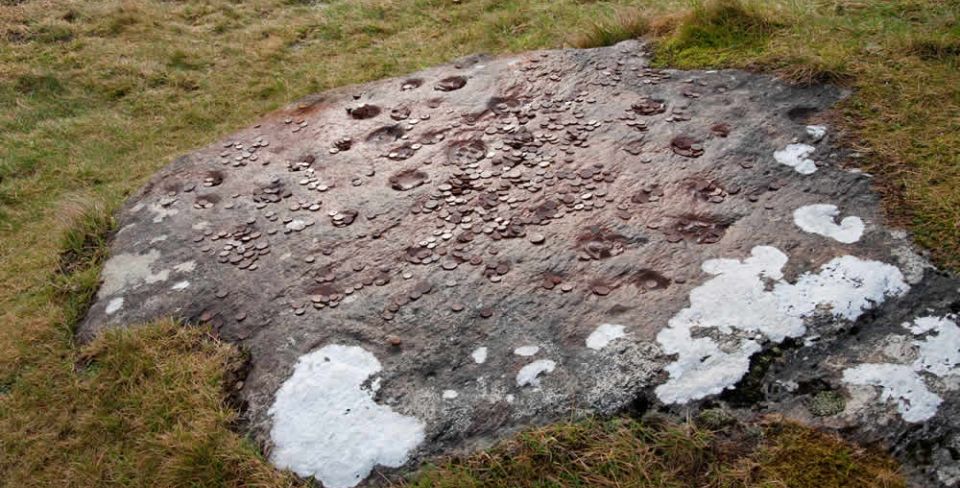3.2 Leac na Cumhaidh
This flagstone at Lacknacoo is one of the places where Colmcille’s mother Eithne is said to have given birth to him. The other place is at nearby Churchtown.
The flagstone is dotted with small ‘cupmarks’. The origins of this ancient monument aren’t known but it may date to the Bronze Age.
In recent times visitors have placed copper coins on the stone leaving rusty marks.
This site was part of a medieval pilgrimage route linking a number of sites in the Gartan area associated with the early life of Colmcille .
According to Manus O’Donnell’s account of Colmcille’s life, on the night before Colmcille was born Eithne saw a vision of a young man. The youth told Eithne that there was a flagstone in Lough Aikkbon which should be brought to Rath Cnó where the saint would be born. The stone was found by Eithne’s family and brought to this place. When Colmcille was born, a cross-shaped niche opened up on the stone. She is also said to have also produced a blood-coloured stone – an cloch ruadh – which was kept in Gartan and which had healing powers.
‘Colmcille was born then on the seventh of December in Gartan in Cenél Conaill, and Rath Cnó is the name of the specific place in Gartan. And the aforementioned flagstone was under him at his birth. The baby lay cross-wise on it and the flag opened so as to make a space for him, and the figure of a cross is on the flagstone from that time to this. This flagstone has remained in that place working miracles and wonders.’
Manus O’Donnell p32
White clay found in a semi-secret location in Gartan – known as Gartan clay – is said to have strong protective powers. Manus O’Donnell links the clay with the birth of Colmcille,
‘Eithne went to a lonely little valley beside a small stream when she went into labour. She sat down in a certain spot there and left in that place some of the blood that comes before the child. Flour isn’t whiter or finer than the clay found there and anyone who eats it or carries it with them is never burned or drowned, nor will they die without a priest. And every woman who eats it in the pangs of childbirth will be helped. And anyone that puts it on their tongue on the first day that they are seized by a fever will have no bitter taste in their mouth as long as the fever lasts. And it is its nature to heal every disease. But it must be one of the natives of Gartan that digs the clay for distribution.’
Manus O'Donnell p32
In the 19th century, many thousands of people left Donegal to live in America, Canada, Australia and New Zealand. Forced off the land by poverty, famine and ruthless landowners, they walked the 30 miles or more to Derry to start their transatlantic journey. When they left Donegal, they knew they would never return.
It became commonplace for emigrants to spend their last night here on the Leac na Cumhadh – the Stone of Sorrows. As Colmcille had decided to exile himself to Scotland, they thought that sleeping here – where he was born – would make their sadness easier to bear.
Up to the 1950s, friends and families would gather here with the emigrants for an ‘American wake’ before walking the first few miles of their journey with them.
An account in Manus O’Donnell’s book of Colmcille’s life gives us the origin of the story and the name:-
“Once he was in a certain place called Gort na Leic (‘Field of the Flagstone’) in Gartan, west of Rath Cnó where he was born. A local man came to him because many of his friends and family had died, and he was distraught and very sorrowful after them. The extent of his sorrow was so great that he would rather die than live after them. And when Colom Cille saw him, he had great pity for him and blessed a flagstone that was beside him and gave that man water from it to drink so that his sorrow disappeared… And Colum Cille left as a grace on that stone that the sorrow of anyone who would drink from it would leave them… “Leac na CumhaIdh” (‘Flagstone of the Sorrows/Loneliness’) is the name of that stone today, in memory of that great miracle.”
Manus O’Donnell p61
The cross was erected by Cornelia Adair in 1911.
Cornelia’s husband was local landowner John Adair. Before they married, Adair had become notorious for the infamous Derryveagh Evictions in 1861 when he had 250 tenants forcibly and violently removed from his land in order to create a huge estate for sheep farming. Many had no choice but to emigrate.
The home of the Adairs – Glenveagh Castle – is nearby. Cornelia is known for the work that she did to enlarge the castle and create the extensive gardens. The castle is now part of Glenveagh National Park
Sitting behind the Leac na Cumhaidh is an earthern mound topped with stones arranged in a U-shape. The origins and date of the mound are unknown.
Gartan – County Donegal
- 3.1 Colmcille Heritage Centre
The Colmcille Heritage Centre sits on the shore of Gartan Lough on the edge of Glenveagh National Park. Displays in the centre tell the story of Colmcille’s early years in the Gartan area and describe the spread of early Christianity in Ireland and Scotland, giving details of monastic and religious life. There...
- 3.2 Leac na Cumhaidh
This flagstone at Lacknacoo is one of the places where Colmcille’s mother Eithne is said to have given birth to him. The other place is at nearby Churchtown. The flagstone is dotted with small ‘cupmarks’. The origins of this ancient monument aren’t known but it may date to the Bronze Age....
- 3.3 Churchtown
Churchtown - Ráth Cnó - is said to be the place where Colmcille’s family lived. According to tradition they later gave over the land so that a monastic settlement could be created here. The site is still used as a turas by pilgrims who walk barefoot between the five marked stations....
- 3.4 Doon Fort & Holy Well
Until the 16th century, the Rock of Doon was the inauguration site of the O’Donnell chieftains. There were two ceremonies - one civil ritual here and one religious ritual which took place at Kilmacrenan. It is likely that this was the site of a fort belonging to the O’Donnells. Manus O’Donnell...
- 3.5 Kilmacrenan
This is where Colmcille is said to have lived with his foster father Cruithneachán. There are two parts to the site - the left hand side is linked to Colmcille while the right side is the site of a 19th century Church of Ireland church. This site formed part of...
- 3.6 Tulach Dubhglaise
Temple Douglas was an ancient monastic site which used to stand on the old road out of Letterkenny, the main route for travellers passing through the area. Colmcille is said to have been baptised here as a Christian in 521 by his foster father Cruithneachán mac Ceallachán. It was common...










Bòrd na Gàidhlig
Great Glen House
Leachkin Road
Inverness
Scotland, IV3 8NW
(+44) 01463 225454
colmcille@gaidhlig.scot
Colmcille
Foras na Gaeilge, 2-6 Queen Street
Belfast
Northern Ireland
BT1 6ED
(+44) 028 9089 0970
colmcille@forasnagaeilge.ie
Colmcille
Foras na Gaeilge, An Chrannóg
Na Doirí Beaga
Gaoth Dobhair
Donegal, Ireland. F92 EYT3
(+353) 074 9560113
colmcille@forasnagaeilge.ie


